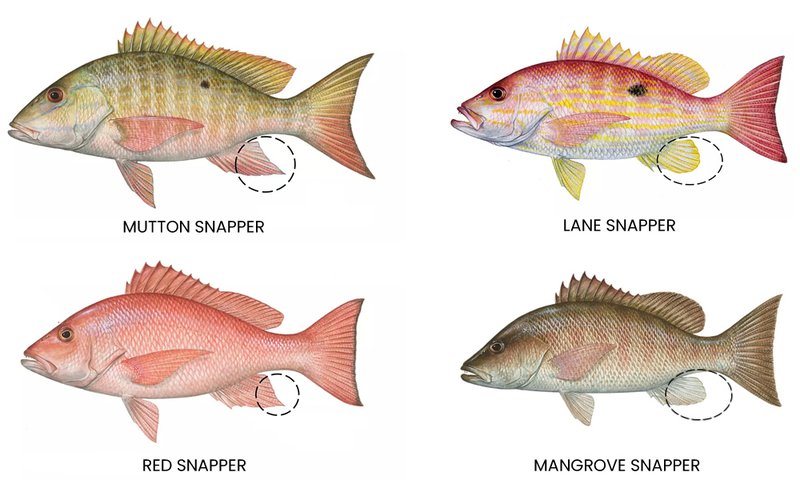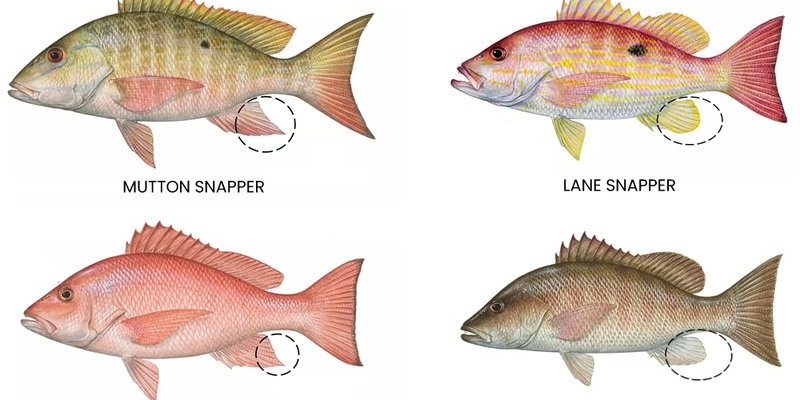
Snapper belongs to the Lutjanidae family, and they are found in warm tropical and subtropical waters. While you might be familiar with several types, like the red snapper, there’s a lot more to these fish than meets the eye. Whether you’re a fishing enthusiast or just curious about marine life, let’s explore what makes snapper so special!
1. A Colorful Cast of Characters
When you picture a snapper, you might be thinking of the well-known red snapper. However, there’s an entire cast of characters in the snapper family! These fish come in various colors and sizes. From the vibrant pinks and reds to deeper hues, you’ll find species like the yellowtail snapper and the mutton snapper, each with its own unique personality.
Snapper can also change color depending on their mood or environment. It’s their way of communicating with each other. Imagine having a mood ring—but for fish! This color-changing ability allows them to signal to potential mates or warn rivals of their territory. Isn’t that fascinating?
2. Master of Camouflage
You might think that fish swim freely in open water, but snapper are true masters of disguise. When they feel threatened, they can cleverly blend into their surroundings. Their coloring and patterns help them hide among rocks, corals, and sea grass. This skill not only helps them avoid predators but also aids in hunting their prey.
Snapper often hunt in groups, using their camouflage to ambush smaller fish. Picture a crew of stealthy ninjas! It’s a strategic advantage that keeps them safe while they’re on the lookout for their next meal.
3. An Appearances Can Be Deceiving
While snapper are typically known for their sweet, mild flavor that many enjoy, they also have a reputation for being a bit tricky to catch. Their sharp, agile movements make them elusive, causing many fishermen to challenge themselves to land one.
If you’ve ever gone fishing for snapper, you probably know that it’s not just about throwing a line in the water. You might have to try different tactics, such as changing your bait or varying your fishing spot. It’s a bit like playing hide-and-seek, where the stakes are high and the thrill is palpable!
4. They’re Long-Lived Fish
Here’s something you might be surprised to learn: snapper have impressive lifespans! Depending on the species, they can live anywhere from 10 to 50 years. Some have even been known to live longer, especially in marine protected areas where fishing pressure is lower.
This long lifespan impacts their populations, making them vulnerable to overfishing. As snapper grow older, they can reproduce more frequently, contributing to the sustainability of their species. It’s a reminder of how important it is to practice responsible fishing!
5. They Have Interesting Social Structures
Snapper are social creatures, often found swimming in groups known as schools. However, within these groups, there’s a hierarchy. Larger, more dominant fish usually claim the prime spots for feeding and breeding, while smaller fish find their place in the pecking order.
This social behavior is fascinating because it shows how snapper communicate and interact with one another. You might even notice them working together when hunting, coordinating their movements to corner prey effectively. It’s like watching a well-rehearsed dance!
6. Their Dietary Preferences
What do you think snapper like to munch on? You might be surprised! While they enjoy smaller fish, they also feast on crustaceans, squid, and various types of marine invertebrates. Their diverse diet shows that they are opportunistic feeders, ready to snag whatever’s available.
Snapper use their keen eyesight to spot potential meals, often hunting at dawn and dusk when their prey is more active. It’s like they have a built-in dinner bell signaling when it’s time to dine!
7. The Importance of Habitat
The environment where snapper live is crucial to their survival. They prefer rocky reefs, mangroves, and seagrass beds, which provide shelter and plenty of food. These habitats are essential not just for snapper, but for many other marine creatures that rely on them for safety and sustenance.
Unfortunately, many of these habitats are threatened by pollution, climate change, and overfishing. Protecting their environments is vital for maintaining healthy snapper populations. It’s a reminder that we all play a role in preserving our oceans!
8. Snapper in Culinary Culture
Snapper is more than just an interesting fish; it’s also a star on dinner plates around the world. From fish tacos to grilled fillets, snapper is prized for its delicate flavor and flaky texture. Many cultures have traditional recipes that highlight its qualities, making it a popular choice among chefs.
Whether you’re enjoying a well-seasoned snapper dish on a beach vacation or preparing a homemade meal, this fish can be a delightful part of your culinary experience. Plus, its versatility means you can cook it in various ways—baked, fried, or even in a stew!
9. Snapper as Indicators of Ocean Health
Snapper play a vital role in ecosystems, acting as indicators of ocean health. Their populations can reflect the overall condition of marine environments. If snapper numbers are declining, it’s often a sign that something’s wrong, such as pollution or overfishing.
Scientists and conservationists use snapper populations to monitor marine ecosystems. Healthy snapper populations usually mean a balanced environment, while troubling declines can prompt further investigations. It’s a reminder of how interconnected everything is in nature!
10. Popular Choices for Aquarists
Finally, if you’re a fish enthusiast, you may be interested in keeping snapper as pets in home aquariums. While they are beautiful and fascinating creatures, they require specific care. Snapper can grow quite large, and they need ample space and the right conditions to thrive.
If you’re considering adding a snapper to your aquarium, ensure you research which species is best for your setup. Some can be more territorial than others, so understanding their behavior is crucial for maintaining a peaceful tank environment.
In essence, snapper fish are much more than just a catch of the day. They’re vibrant, social creatures with unique traits that make them special in the marine world. Whether you’re watching them swim in the ocean or enjoying them on your plate, there’s so much to appreciate about these fish. Let’s continue to learn more about them and their environment to ensure they thrive for generations to come!

